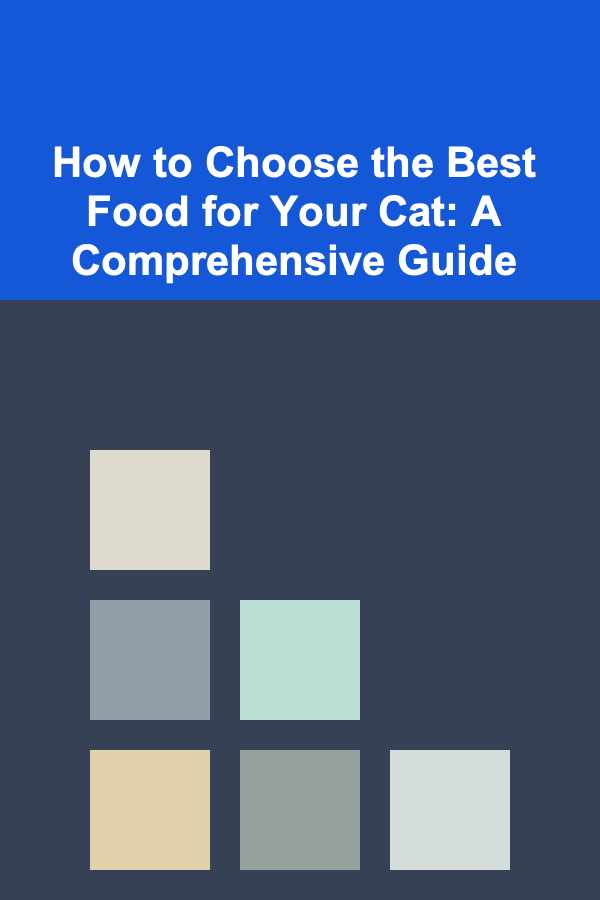
How to Choose the Best Food for Your Cat: A Comprehensive Guide
ebook include PDF & Audio bundle (Micro Guide)
$12.99$7.99
Limited Time Offer! Order within the next:

Choosing the right food for your cat is one of the most important decisions you'll make for their health and well-being. A proper diet can contribute to a longer, healthier, and happier life for your feline companion. However, navigating the vast array of cat food options can be overwhelming. This guide aims to provide a comprehensive overview of the key factors to consider when selecting the best food for your cat, ensuring you make informed decisions based on their individual needs and life stage.
Understanding Your Cat's Nutritional Needs
Cats are obligate carnivores, meaning their bodies are biologically designed to thrive on a diet primarily composed of animal-based protein. Unlike dogs, which can adapt to more omnivorous diets, cats require certain nutrients found exclusively in animal tissues. A deep understanding of these essential nutritional requirements is paramount to providing optimal nutrition.
Essential Nutrients for Cats:
- Protein: A cornerstone of a cat's diet. Protein provides the building blocks for muscle tissue, enzymes, hormones, and antibodies. Cats need a higher protein intake than many other animals. Look for foods that list a named meat source (e.g., chicken, turkey, salmon) as the primary ingredient. Avoid foods where "meat by-products" or "animal digest" are the first ingredients, as the quality and source of these ingredients can be inconsistent.
- Taurine: An essential amino acid that cats cannot synthesize on their own. Taurine is vital for heart function, vision, digestion, and reproduction. A taurine deficiency can lead to serious health problems like dilated cardiomyopathy (DCM) and retinal degeneration. All commercially prepared cat foods should be supplemented with taurine.
- Arachidonic Acid: Another essential fatty acid that cats cannot produce themselves. It's important for inflammation regulation and blood clotting. Animal fats are the primary source of arachidonic acid.
- Vitamins: Cats require various vitamins, including vitamin A, vitamin D, and B vitamins. Vitamin A, in particular, is crucial for vision and immune function, and cats cannot convert beta-carotene from plants into vitamin A as efficiently as other animals.
- Minerals: Essential minerals like calcium, phosphorus, magnesium, and potassium are necessary for bone health, nerve function, and electrolyte balance. The ratio of calcium to phosphorus is particularly important for preventing urinary tract problems.
- Water: While technically not a nutrient, water is absolutely critical for a cat's health. Cats have a low thirst drive and often rely on their food for hydration. Chronic dehydration can lead to kidney problems and urinary tract issues. Therefore, providing fresh, clean water at all times is essential. Consider supplementing dry food with wet food to increase your cat's water intake.
The Importance of Ingredient Quality
The source and quality of ingredients are just as important as the nutrient composition. Look for foods that use high-quality, identifiable ingredients. For example, instead of "poultry by-product meal," look for "chicken meal" or "turkey meal." "Meal" refers to the rendered and dried animal tissue, which is a concentrated source of protein. While by-products can be nutritious, it's difficult to assess their quality without knowing their specific origin. Avoid foods with excessive fillers like corn, wheat, and soy, as these offer limited nutritional value for cats.
Types of Cat Food
Cat food comes in various forms, each with its own advantages and disadvantages. Understanding the differences between these options will help you choose the best fit for your cat's needs and your lifestyle.
Dry Food (Kibble)
Advantages: Dry food is convenient, economical, and helps promote dental health by mechanically cleaning the teeth as the cat chews. It has a long shelf life and can be left out for extended periods, making it suitable for cats who like to graze throughout the day.
Disadvantages: Dry food typically has a lower moisture content than wet food, which can contribute to dehydration, especially in cats prone to urinary tract problems. Some dry foods contain a higher proportion of carbohydrates than is ideal for cats. The processing methods used to create kibble can also denature some nutrients. Look for high-quality dry food with a high meat protein content and minimal fillers.
Wet Food (Canned or Pouches)
Advantages: Wet food has a high moisture content, which is beneficial for hydration and kidney health. It's often more palatable than dry food, making it a good choice for picky eaters or cats with dental problems. Wet food typically contains a higher proportion of protein and a lower proportion of carbohydrates than dry food.
Disadvantages: Wet food is more expensive than dry food and has a shorter shelf life once opened. It can also contribute to dental tartar buildup if not supplemented with dental treats or regular teeth brushing. The strong odor of some wet foods can be unappealing to some owners.
Semi-Moist Food
Advantages: Semi-moist food is palatable and has a slightly higher moisture content than dry food. It's often formulated to be highly appealing to cats.
Disadvantages: Semi-moist food often contains high levels of sugar, salt, and artificial preservatives, making it a less healthy option than dry or wet food. It is generally not recommended as a primary food source for cats.
Raw Food Diets
Advantages: Raw food diets, often consisting of raw meat, bones, and organs, are designed to mimic a cat's ancestral diet. Proponents of raw feeding claim that it leads to improved digestion, a shinier coat, and increased energy levels. When properly formulated and prepared, a raw diet can be highly nutritious.
Disadvantages: Raw food diets can pose a risk of bacterial contamination (e.g., Salmonella, E. coli) if not handled and prepared properly. They also require significant time and effort to prepare and balance. Improperly balanced raw diets can lead to nutritional deficiencies or excesses. Raw diets are generally not recommended for households with young children, elderly individuals, or immunocompromised individuals due to the risk of bacterial transmission. Consultation with a veterinary nutritionist is crucial before transitioning your cat to a raw food diet.
Homemade Diets
Advantages: Homemade diets allow you to control every ingredient that goes into your cat's food, ensuring high-quality ingredients and minimizing the risk of allergies or sensitivities to specific additives. They can be tailored to meet specific health needs or dietary restrictions.
Disadvantages: Homemade diets require significant time, effort, and nutritional knowledge to formulate correctly. It is extremely difficult to balance a homemade diet without the guidance of a veterinary nutritionist. Improperly balanced homemade diets can lead to serious nutritional deficiencies and health problems. Therefore, homemade diets should only be considered under the supervision of a qualified professional.
Factors to Consider When Choosing Cat Food
Selecting the best food for your cat is not a one-size-fits-all approach. Several factors must be considered to ensure you're meeting their individual needs.
Life Stage
A cat's nutritional requirements vary depending on their life stage. Kittens, adults, and senior cats have different needs for protein, fat, and other nutrients.
- Kittens (up to 1 year): Kittens require a diet that is high in protein and calories to support rapid growth and development. They also need higher levels of calcium and phosphorus for bone growth. Choose a food specifically formulated for kittens or "all life stages."
- Adult Cats (1-7 years): Adult cats need a balanced diet to maintain their weight and energy levels. Choose a food formulated for adult maintenance, focusing on high-quality protein and moderate fat levels.
- Senior Cats (7+ years): Senior cats may have decreased kidney function, reduced muscle mass, and decreased activity levels. They may benefit from a food that is lower in phosphorus, higher in fiber, and contains added joint support nutrients like glucosamine and chondroitin. Some senior cats may also require more palatable food due to decreased sense of smell or dental problems.
Health Conditions
If your cat has any underlying health conditions, such as kidney disease, diabetes, food allergies, or urinary tract problems, you'll need to choose a food that is specifically formulated to address these issues. Consult with your veterinarian to determine the best dietary approach for your cat's specific needs. Therapeutic diets are available for many common feline health problems and can play a crucial role in managing their condition.
Activity Level
Active cats require more calories than sedentary cats. If your cat is very active, choose a food that is higher in calories and protein to support their energy needs. Indoor-only cats, on the other hand, may require a food that is lower in calories to prevent weight gain.
Weight Management
Obesity is a common problem in cats, and it can lead to a variety of health problems, including diabetes, arthritis, and heart disease. If your cat is overweight, you'll need to choose a food that is lower in calories and higher in fiber to help them lose weight. Weight management diets are specifically formulated to promote weight loss while maintaining muscle mass. Portion control is also crucial for weight management. Work with your veterinarian to determine the appropriate calorie intake for your cat.
Food Sensitivities and Allergies
Food allergies and sensitivities can cause a variety of symptoms in cats, including skin problems, digestive upset, and respiratory issues. Common food allergens in cats include beef, dairy, chicken, and fish. If you suspect your cat has a food allergy, your veterinarian may recommend an elimination diet trial to identify the offending ingredient. This involves feeding your cat a novel protein source (e.g., duck, rabbit, venison) or a hydrolyzed protein diet for several weeks to see if their symptoms improve. Hydrolyzed protein diets contain proteins that have been broken down into smaller pieces, making them less likely to trigger an allergic reaction.
Budget
Cat food prices can vary widely, so it's important to consider your budget when making your selection. While it's tempting to choose the cheapest option, remember that higher-quality foods often provide better nutrition and may ultimately save you money in the long run by reducing the risk of health problems. Compare the ingredient lists and nutrient profiles of different foods to determine the best value for your money. Consider buying food in bulk to save money, but make sure you store it properly to maintain its freshness and prevent contamination.
Reading Cat Food Labels
Understanding how to read a cat food label is essential for making informed choices. Here are some key things to look for:
- Ingredient List: Ingredients are listed in descending order by weight. The first few ingredients make up the majority of the food. Look for a named meat source (e.g., chicken, turkey, salmon) as the first ingredient.
- Guaranteed Analysis: The guaranteed analysis lists the minimum percentages of crude protein and crude fat, and the maximum percentages of crude fiber and moisture. It provides a general indication of the nutrient content of the food. However, it doesn't tell you anything about the quality of the ingredients.
- AAFCO Statement: The Association of American Feed Control Officials (AAFCO) statement indicates whether the food is "complete and balanced" for a specific life stage. Look for a statement that says the food "is formulated to meet the nutritional levels established by the AAFCO Cat Food Nutrient Profiles for [life stage]." This statement indicates that the food has been tested and meets the minimum nutritional requirements for cats.
- "Natural" Claim: The term "natural" is loosely regulated in the pet food industry. It generally means that the food does not contain artificial colors, flavors, or preservatives. However, it doesn't necessarily mean that the food is healthier or of higher quality.
- "Grain-Free" Claim: Grain-free foods are often marketed as being healthier for cats. However, there is no scientific evidence to support this claim. Grains can be a source of carbohydrates, fiber, and other nutrients. Some grain-free foods replace grains with other carbohydrates, such as potatoes or peas, which may not be any healthier for cats. The FDA is currently investigating a potential link between grain-free diets and dilated cardiomyopathy (DCM) in dogs and cats, although the exact cause is still unknown. It's important to consult with your veterinarian before switching your cat to a grain-free diet.
Transitioning to a New Food
When switching your cat to a new food, it's important to do so gradually to avoid digestive upset. Here's a general guideline:
- Days 1-3: Mix 25% of the new food with 75% of the old food.
- Days 4-6: Mix 50% of the new food with 50% of the old food.
- Days 7-9: Mix 75% of the new food with 25% of the old food.
- Day 10: Feed 100% of the new food.
If your cat develops diarrhea or vomiting during the transition, slow down the process or consult with your veterinarian.
Monitoring Your Cat's Health
Once you've chosen a food for your cat, it's important to monitor their health and well-being. Look for the following signs:
- Healthy Coat: A healthy coat should be shiny and smooth.
- Good Energy Levels: Your cat should be active and playful.
- Normal Stool: Stool should be well-formed and easy to pass.
- Healthy Weight: Your cat should maintain a healthy weight without being overweight or underweight.
- Clear Eyes and Nose: There should be no discharge from the eyes or nose.
If you notice any changes in your cat's health, consult with your veterinarian.
The Role of Your Veterinarian
Your veterinarian is your best resource for information on cat nutrition. They can assess your cat's individual needs and recommend the best food based on their life stage, health conditions, and lifestyle. Don't hesitate to ask your veterinarian for advice on choosing the right food for your feline companion. Regular checkups and blood work can help detect any underlying health problems that may require dietary adjustments.
Conclusion
Choosing the best food for your cat requires careful consideration of their individual needs, life stage, health conditions, and your budget. By understanding the essential nutrients that cats need, the different types of cat food available, and how to read a cat food label, you can make informed decisions that will contribute to your cat's overall health and well-being. Remember to consult with your veterinarian for personalized recommendations and to monitor your cat's health closely to ensure they are thriving on their chosen diet. Providing your cat with the right nutrition is a significant investment in their long and happy life.

Creative Strategies for Lowering Cell Phone Bills While Keeping Your Data
Read More
How to Organize Fishing Tools for Quick Access
Read More
How to Start a Greeting Card Design Business from Home
Read More
How to Use Console Tables for Stylish Storage Solutions
Read More
How to Use Trunk Organizers for Better Storage Solutions
Read More
Why You Should Create a Digital Backup for Important Documents
Read MoreOther Products

Creative Strategies for Lowering Cell Phone Bills While Keeping Your Data
Read More
How to Organize Fishing Tools for Quick Access
Read More
How to Start a Greeting Card Design Business from Home
Read More
How to Use Console Tables for Stylish Storage Solutions
Read More
How to Use Trunk Organizers for Better Storage Solutions
Read More